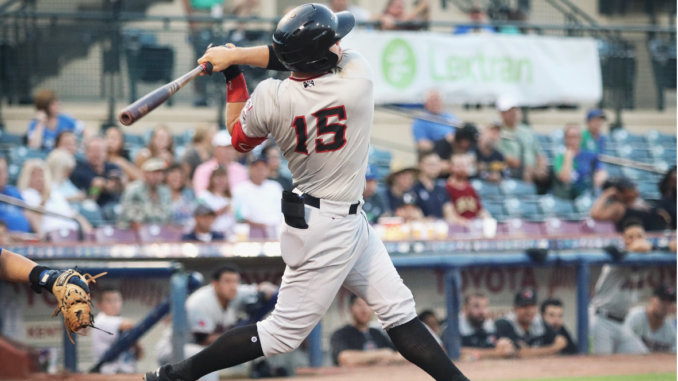
In the first installment of this series we talked about the basic definition of a rebuild and how commissioners can make this a healthy option in dynasty leagues. We also covered some prerequisite considerations for GMs looking to undertake a rebuild project. In this installment I will break down specific techniques for rebuilding a team and how to know if it’s time to consider a rebuild for your squad.
Timing:
If you take nothing away from this series, take this away…it takes ASSETS to functionally rebuild a fantasy team. If you are not realistic about the value of the assets on your team and your actual chances to win your league, you can easily wait too long to rebuild. The more assets you start with, the easier and more quickly you can cash in their value for future assets like prospects and draft picks. The calculus for deciding to rebuild varies greatly depending on the circumstances involved. For instance, a team in the bottom third of the standings in a 16-team league may be a lot closer to competing for a championship than a team in the bottom third of a 30 team league. For GMs in a salary style or limited contract dynasty league, the length of time their players are under team control can be a huge factor. The only way to determine whether or not a rebuild is in order is to honestly evaluate your team against the other teams in your league and your chances of winning the league in the next two or three seasons. Can you win with your current core of players? If so, what moves would you need to make in the short term to get to that point? Can you realistically make those moves? These are the kinds of questions you need to ask yourself if you are at the bottom of the league standings for 2 or more years running.
Tip #1: Turn Short Term Assets into Long Term Assets
Once a GM has made the decision to start a full rebuild, the clock immediately starts ticking on all of their short term assets. At the start of any rebuild, the first thing to be done is to get all the value you can from assets that have an expiration date. First, let’s define short term and long term assets and then I’ll jump into some specific strategies.
Short Term Assets:
- Players that you control for only 1 or 2 seasons including the current season. This applies in dynasty leagues with contracts or player retention limits. If you have some risk of losing that player to another team before your rebuild is over, they are expendable.
- Players that are likely to experience significant performance decline while you still control them. Maybe it’s an older player or a player that is clearly over performing his talent. These guys are like a carton of milk. Don’t end up pouring half of the value down the drain; sell them while they have value.
- Players that don’t fit your strategy. Some guys don’t mind a guy that hits .220 if his home run total is right. Others don’t want that player. Those guys that don’t fit your mold are perfect ammunition to get future assets that do fit your profile.
Long Term Assets:
- Young players with multiple years of team control.
- Prospects that have legitimate, gradable talent. This will be your lifeblood, but don’t waste roster space on pipe dreams.
- Draft picks. Buy them, sell them, use them. They are the golden ticket to getting deals done and stocking your roster with talent.
Your first job is to turn every player on your team that fits into category 1 into assets that fall into category 2. This is critical because every asset that falls into the first category is losing value with time. Get the most value you can for these guys as quickly as you can. Of course, the urgency varies by the value of the asset. A premium player, even if he falls into the short-term category, should be dealt carefully for maximum value.
There are several strategies for getting value out of your short term assets including a public trade block that identifies the players you are shopping. I’ve found some success in what I call “trade matchmaking” where I approach a particular manager that has a need that one of my players fills. The key is to be active. Keep your available assets advertised. Look for possible matches with other owners and initiate trade talks yourself. Identify owners that are looking to compete and watch their teams for trade opportunities.
Tip #2: Be the Bank
I prefer (and compete exclusively in) salary style dynasty leagues with a salary cap and player contracts. This tip is somewhat specific to these leagues, but the principle applies to all formats. Once you’ve emptied your team of short term assets you will likely have plenty of salary cap and roster space having gotten rid of your expensive short term players. Use this space to provide salary and roster relief to other owners for a fee. Perhaps a contender has an underperforming player with a high salary. Shedding that contract frees them up to sign more productive players and/or bring in new players via trade. Often a contending team will trade prospects or draft picks with the player in order to get rid of them. I estimate I did at least a dozen or more deals like this and gained as many solid prospects during my rebuild. You can also scan the free agent market for players that are unsigned but have potential to help a team at some point in the season. Sign these players to short term deals with an eye toward trading them for prospects or picks around the trade deadline.
Taking on bad contracts is a great way to build value on your team, but don’t hamstring yourself for future seasons. When your prospects start to blossom and you’re nearly ready to compete again, you want to have lots of cap room to add veterans to your team. If you’re going to take on a bad contract, make sure you have a plan for the contract buyout and that you are free of that salary no later than the coming offseason. A couple of prospects is not worth sitting on a bad contract for 3 or more seasons.
Remember, you’re not competing right now, so be creative. One of my favorite moves I made during my rebuild was an offseason trade I made for Aroldis Chapman. He was on an expiring deal at a very high salary relative to his value. I made the trade right before the season when there were other closers still available in free agency and there was little to no market for trading him. The other owner wanted cap relief to seek out other players in the free agent market. I had the cap room and there wasn’t any risk since the deal was expiring. I felt that even though there was no market for him at that time that eventually the market would develop. I traded Addison Reed and a 3rd Round prospect pick for Chapman and a 2nd Round pick while taking on about $20m in cap. I didn’t need the cap space during my rebuild, so it was an easy gamble to make. To make a long story short, I eventually found a buyer for Chapman and made a number of subsequent trades. My final haul in exchange for Reed and a 3rd Round Pick? Salvador Perez, MJ Melendez, Josh Stowers and two 2nd round picks. Every trade was reviewed by a trade panel and every one of them was a fair trade, but because I was patient enough to take a bad contract and work the market, I came away with a big profit. You can do a rebuild without those type of deals, but it will take longer. If you can get something for nothing other than your patience and hard work, you’ll get there faster.
Tip #3: Dominate the Draft
This is my favorite part of building a team. Draft picks allow so many additional, perfectly legitimate trades to happen because they allow teams to get future value. If you’re rebuilding a team, you want draft picks and lots of them. You want them not just to select players but also to help you make trades in and around the draft. I’m not going to elaborate on this much more because this is pretty obvious. If you are rebuilding, no one that is not rebuilding should have more draft picks than you. Try to get a pick thrown in on every deal you do and dominate the draft.
Tip #4: Choose the Right Prospects
If you’re an experienced dynasty owner, you probably already know that finding hitting prospects that pan out is much easier than pitchers. Pitchers have a lower rate of making a fantasy impact in the majors and many will only make it as middle relievers. Add to that the risk of Tommy John surgery and the risk/reward on pitching prospects is much lower. That doesn’t mean don’t hold any pitching prospect, but you need to look at their value realistically and don’t build your team with 30 pitching prospects, unless you have a minor league roster of 80-100 or more.
Remember when you are acquiring prospects that you are looking for fantasy value, not real-life value. MLB teams look at many factors in evaluating players that go beyond what is quantified on the fantasy scoreboard. Is this player going to hit enough to play every day? That may mean the difference between a hitter you can use and one that is a waste of roster space. Does this pitcher have two plus pitches or three? That may be the difference between a starting pitcher you can use every week and a middle reliever that you will cut from your squad. When you reference prospect rankings and articles, put more weight on the articles that are written from a fantasy perspective.
Carrying the right mix of prospects is also important in building your team for the future. You want to have a number of options at each lineup position, because most prospects don’t end up as regular fantasy contributors. You are going to miss on some guys, but if you carry the right mix you have a better chance of having a complete team. Depending on your league setup you may also want to have your prospects arrive in waves due to salary increases and contract lengths. Build your team to suit the settings and specifics of your league.
In the final installment of this series we will look at what I call “The Pivot.” Every rebuild project can and should come to an end and result in a competitive team in “win now” mode. Making that transition is tricky and I’ll talk about some of the techniques I used to make the transition. In the meantime, if you have any comments or questions, post them below in our Comments section, and/or hit me up on Twitter at @ChappyIsClutch.





Hey Jared thank you for the great information. I was recently asked to assume an NL only dynasty team that is decimated. I like a challenge, and I’ve had success in MLB only leagues, but I’m underwater with this endeavour. This website has been a great resource. Do you have any specific tips with regard to identifying minor leaguers to target? I have discovered that most of my competition have full minor league systems, while the previous owner of this team left me with one minor leaguer, Adonis Medina, who may not pan out. Thank you for any thoughts or info.
Thanks for reading, Bill! I’m glad that you’ve found the information helpful. I’ve had a number of people reach out to me on Twitter for help with their rebuilds and have had some really good conversations. If Twitter is an option for you, we can have a more detailed conversation about your league setup and what your team looks like.
In this setting, I’ll give you some rules of thumb that I use when acquiring prospects:
1.) Do your research. Read about the player from multiple sources and come to your own conclusions about the player. Don’t let the other owner sell you on the player.
2.) Take into account the age of the player relative to their experience. A 23yo player tearing up low A ball is different than a 19yo doing the same. A college player just drafted is closer to the majors than the 18yo high school kid taken 3 picks before him, but he might not have the same fantasy potential.
3.) Weigh upside versus bust potential. This is especially true when acquiring very young players like high school draftees and international free agents. Many of the game’s biggest stars turned pro very young, but the number of those players that never made it close to the majors is enormous. Make your bets on these guys selectively.
4.) Balance your prospect roster by position…to a point. You don’t want to have all guys from one position or all hitters and no pitchers, etc. That said, be selective about which pitchers you target because the bust rate, tommy john risk and middle reliever outcomes are real. Also, many of the top hitters in the game start out at middle infield positions because at the amatuer levels that’s where the best players play. I like to have a disproportionate number of middle infield prospects because I know some of them will end up at 3B and some in the OF, but they have the best tools to make it in the big leagues.
5.) Target guys that fit your strategy. This is league setup dependent. As an example, though it may not be the best real life metric of player value, I personally really like batting average when evaluating a fantasy player. I find that the guys that really make a difference in winning fantasy championships are the ones that produce the counting stats while holding a high batting average. I tend to target guys that are going to hit a lot. That’s one of my strategies. If you have theories like that on how to win, ask yourself how this player fits into that strategy.
I’m sure I could come up with more, but that’s what I’ve got for you at the moment. Thanks again for reading and good luck with your build!